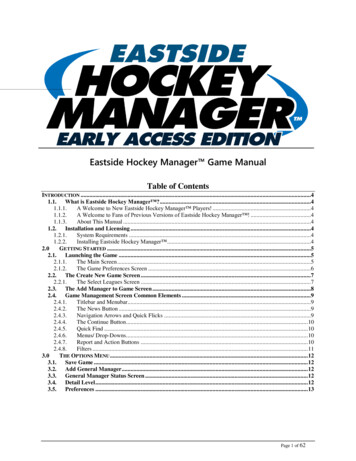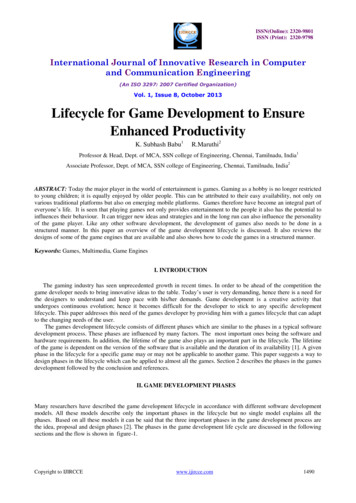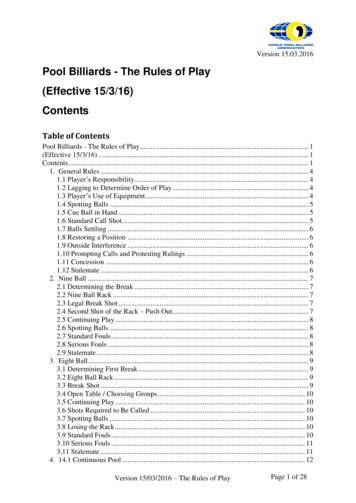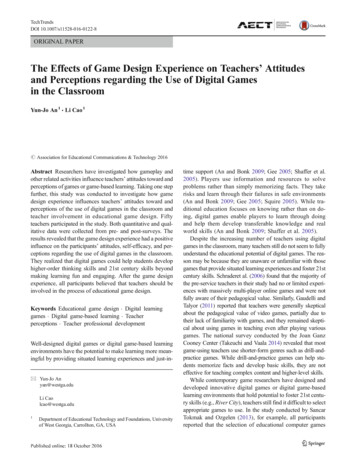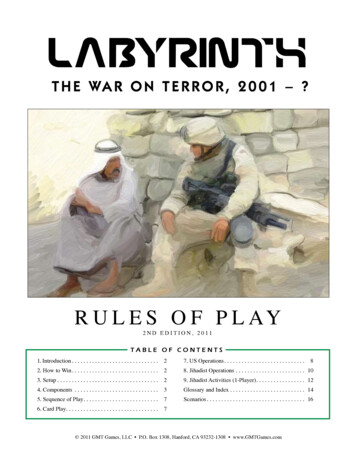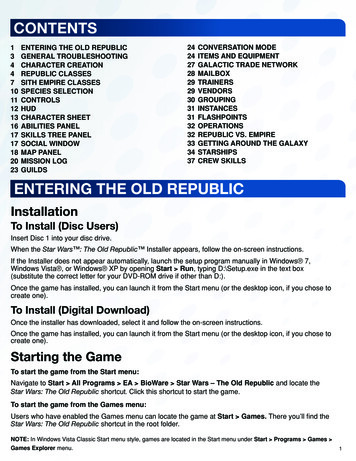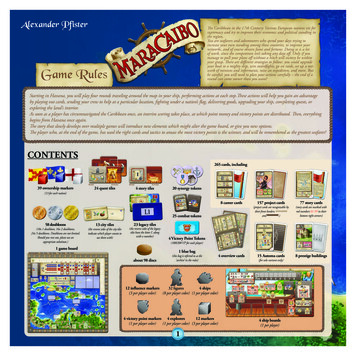
Transcription
Alexander PfisterThe Caribbean in the 17th Century: Various European nations vie forsupremacy and try to improve their economic and political standing inthe region.You are seafarers and adventurers who spend your days trying toincrease your own standing among these countries, to improve yournetworks, and of course obtain fame and fortune. Doing so is a lotof work, since the competition isn’t taking any days off. Only if youmanage to pull your plans off without a hitch will victory be withinyour grasp. There are different strategies to follow: you could upgradenetyour boat to a mighty ship, win swordfights, go on raids, set up a network of minions and informants, raise an expedition, and more. Butbe careful: you will need to plan your actions carefully – the end of around can come sooner than you want!Game RulesStarting in Havana, you will play four rounds traveling around the map in your ship, performing actions at each stop.These actions will help you gain an advantageby playing out cards, sending your crew to help at a particular location, fighting under a nation’s flag, delivering goods, upgrading your ship, completing quests, orexploring the land’s interior.As soon as a player has circumnavigated the Caribbean once, an interim scoring takes place, at which point money and victory points are distributed. Then, everythingbegins from Havana once again.The story that slowly develops over multiple games will introduce new elements which might alter the game board, or give you new options.The player who, at the end of the game, has used the right cards and tactics to amass the most victory points is the winner, and will be remembered as the greatest seafarer!CONTENTS265 cards, including39 ownership markersfrontreverse24 quest tilesfrontreverse4 story tiles20 synergy tokens(13 for each nation)8 career cards25 combat tokens58 doubloons(18x 1 doubloon, 16x 2 doubloons,24x 5 doubloons. Doubloons are not limited.Should you run out, please use anappropriate substitute.)13 city tiles(the reverse sides of the city tilesindicate which player counts touse them with)23 legacy tiles(the reverse sides of the legacytiles have the letter L alongwith a number)157 project cards77 story cards(project cards are recognizable bytheir front borders:and.)(story cards are marked withred numbers 01-99 in theirbottom right corners)15 Automa cards8 prestige buildings1004 Victory Point Tokens(100/200 VP for each player)1 game board1 blue bagabout 98 discs(this bag is referred to as the‘archive’ in the rules)4 overview cards(for solo variant only)12 influence markers32 figures4 ships(3 per player color)(8 per player color) (1 per player color)4 victory point markers 4 explorers12 markers(1 per player color)(1 per player color) (3 per player color)14 ship boards(1 per player)
Setup before your first game:THE GAME BOARD1 Place the game board featuring the Caribbeanso that all players can easily reach it.Space forremoved discsand displacedownershipmarkers2 Shuffle the combat tokens and place them intwo face-down piles in the corresponding area.71Income Track (Doubloons)11F11D8Influence Track14a*14 14c*311B5Income Track (Victory Points)211F414b*4411C6Explorer Track34 In a 2-player game only, cover the city ofMaracaibo on the board with the Maracaibo citytile.In a 3- or 4-player game, return the Maracaibo city tileto the box – you won’t need it.Then, look for the remaining city tiles that havenumbers on them matching your player count, andreturn the rest to the box. Take the two city tilesand randomly choose two more.marked with aShuffle the four tiles and then randomly place themonto the spaces intended for them in the followinglocations: Puerto Plata (No. 4), Santo Domingo (No.5), Port Royal (No. 13), and Cartagena (No. 14).5* Separate the project cards into A-cards411A3 Shuffle the quest tiles and place them in a faceup pile in the corresponding area. Make sure theyare orientated correctly, i.e. with the lighter-coloredplanks at the top.Take three quest tiles and place them onto the threespaces intended for them on the explorer track atthe bottom of the board.338 Place the ownership markers onto the like-colored spacesto the left of the influence track (France blue, England white, Spain red). Place a single marker on the left-mostspace, and two on the remaining spaces.In a 2-player game only, immediately place a red ownership markeronto the village at No. 6 (San Juan), a white ownership marker ontothe village at No. 7 (St. Kitts), and a blue ownership marker onto thevillage at No. 8 (Martinique). When adding ownership markers tothe board, always take the left-most available marker.7 Shuffle the prestige buildings andplace four of them along the top of thegame board – a face-up card on theI space, and three face-down cards onspaces II to IV. Return the remainingprestige buildings, unseen, to the box –they won’t be used this game.(Variant: Allowing for better planning,place all four prestige buildings face-up.)2(recognizable by this rope:) and B-cards(recognizable by this rope:).Shuffle the piles of A-cards and B-cards separately.Then, deal each player 8 cards from the A-cardpile. Count out 40 cards from the B-card pile andshuffle these with the remaining A-cards. Return therest of the B-cards to the box – they won’t be usedthis game. Place the shuffled pile of cards, facedown, next to the game board.Reveal the top four cards of the pile and place thesein a display next to the pile.6 Place the doubloons and synergy tokens next tothe game board as a general supply. Place the victorypoint tokens next to the general supply.* Note: Project cards consist of 56 A-cards and 101B-cards; story cards consist of 77 cards (69 plus 8C-cards). Story cards are not consecutively numbered.
PLAYER SETUP9 Give each playera ship board, placing itin front of them.10 Place 2 discs onto each of the indicated circularspaceson your ship board. You will place a total of24 discs. (Instead of stacking the discs, you can place themnext to each other.)151211 Give each player all of the wooden components in their chosen player color. Eachplayer then places:planning spaces11E111011Atheir victory point marker onto space 0 of the victory point track on thegame board,11Btheir ship onto the Havana space on the game board,11Ctheir explorer onto the start space of the explorer track on the game board,11Done of their influence markers onto space 0 of each nation’s influence track,11Eone of their markers onto space 1 of their ship board’s combat track.11Fone of their markers onto space 8 of the doubloon income track, and thelast of their markers onto space 0 of the victory point income track.12 Additionally, give each player:- two figures of their color- two career cards- one overview cardFirst Decisions14 To play the standard game without campaign, search for story card 75 in thepile and place it onto the corresponding space 14 on the game board. Read thecard and follow its instructions (draw quest tiles and add them to various locations depending on the number of players [15, plus possibly 18 and 19]).In later games, instead of card 75, you can use story cards 76 or 77 that bringlegacy tiles into the game. Read the card and follow the instructions (place questson the corresponding locations, shuffle the indicated story cards into the pile withthe project cards, lay out legacy tiles). Place the unused legacy tiles and story tilesback in the box.Place the remaining figures into the generalsupply. Return any remaining career and overview cards to the box.15 Now, each player chooses what to dowith the eight project cards theywere dealt.a. Keep four cards in hand,b. Add one card to one of the threeplanning spaces above your ship, andIf you would like to start the campaign in your first game, please read the section“Campaign” at the bottom of this page and follow the instructions there.If you don’t want to play the campaign, ignore all rules marked with Campaign only.CAMPAIGNThe campaign in Maracaibo will take you through theports of the Caribbean islands over multiple rounds.Through story cards and legacy tiles the rules willchange, new possibilities will open up and you willhave to overcome obstacles. Each game is differentfrom the last and your decisions influence what willhappen.If you want to play the campaign, some parts of thesetup are modified. When a rule is only relevant for thecampaign, you will find the reference Campaign onlyat the beginning of the explanation.c. Add three cards to the discard pile.13 The start player is the playerwho was most recently on board aship. Give that player 8 doubloons.Give the next player in clockwisedirection 9 doubloons. Give thethird player 10 doubloons, and thefourth player 11 doubloons.16 Finally, all players simultaneously choose which one of their twocareer cards to keep. Place the chosencard next to your ship board, andreturn the other to the box.Then, take three figures ofyour color from the general supply and place themonto the correspondingspaces on the career card.Game setupGame setupSet up the game as usual, but skip number 14 of thesetup and follow these instructions instead:Setup the game as usual, but with the following changes:(first game):(from the second game on):Lay the story cards aside. You can recognize themby the red number in the lower right corner.Sort the four story tiles in ascending numerical orderand place them next to the stack of quest tiles, so thatthe story tile with the „1“ is visible.14a*14b*Place the legacy tiles face down next to the generalsupply.Place story card 01 onto the corresponding space14c* on the game board. Read the card and followits instructions: Place story tile 1 next to the indicatedlocation (15). Draw quest tiles from the pile and placethem face-up next to the indicated locations (16 andpossibly 19 [in a 4-player game]).14c*3If you want to pick up where you left off, take all storycards out of the archive (blue bag) and add them to thecorresponding space on the game board. Read the storycards and follow their instructions (i.e. add quests tovarious locations). Add all legacy tiles from the archiveto their appropriate positions on the game board. Theremay be C-cards from your previous game(s) in theproject cards pile. C-cards are introduced by story cardsand have the numbers 90-99 in the lower right corner.In step 5 , shuffle these C-cards with the A-cards, i.e.C-cards will be carried from one game to the next.If you want to play a specific chapter, choose oneof story cards 80-89 and add it to the correspondingspace on the game board. Story card 80 is for chapter2, Story card 81 for chapter 3, etc. Read the card andfollow its instructions as usual. The card may alsoindicate particular legacy tiles to add to the game andC-cards to shuffle with the A-cards (step 5 ).
GAMEPLAY- Locations with this symbol cannot be skipped. You mustend your movement when you reach one of these locations!You are allowed to skip over any other locations, as long asyou have enough movement points to do so.Maracaibo is played over four rounds. A round ends as soon as oneplayer’s ship reaches the last space on the game board. Then an interimscoring takes place. After the fourth round, a final scoring takes place,after which the game is over.Note: Later games may introduce new cities for you to sail to. You mayalso find that sailing between certain locations requires more movementpoints, or is otherwise affected by new rules. Should any of those changescontradict these rules, then the new instructions overrule.On your turn, you perform the following steps in order:Phase A) SailingMove your ship forward from 1 to 7 locations.Phase B) Main ActionPerform a main action at the location your ship is at, along with as manyfree actions as you like.Phase B) Perform a main action at the location yourship is at, along with as many free actions as youlikePhase C) Draw CardsDraw cards back up to your hand limit.Depending on where your ship is located, you may now perform onemain action:As soon as you have completed Phase C, your turn is over and it is theturn of the next player in clockwise direction.?Phase A) Move your shipforward from 1 to 7locationsAIn this phase, you have up to 7 movement points. You must move at leastone location forward. You are free to use as many of your 7 movementpoints as you like. Any unused movement points are lost.If your ship is at a city, you may first deliver a good andthen perform the indicated city action.If your ship is at a village, you may perform a village action A . If you spent 4 to 6 movement points in Phase A,you can perform two village actions AA . If you spent all 7movement points in Phase A, you can perform three villageactions AAAA .If there is a quest at the location, you can fulfill it.When sailing:- Each white circle with a number is a location. Cities arelocations with a scroll depicting an action next to them.All other locations are villages. One move means movingfrom a location to the next one along the arrow. Unlessindicated otherwise, one movement point per move isrequired.If your ship is at a location with one or more of yourassistants in it, you may perform their special assistantaction (only one).The ‘homeward bound’ spaces (20, 21a, 21b, 22)are special city locations. You cannot skip them,nor can you deliver goods there.- All movement must be in the direction indicated by arrows. Ifthere are multiple arrows leading from a location, you can choosewhich path to take.- You are not allowed to sail backward, i.e. against the movementdirection indicated by an arrow.If your ship is at a location where more than one of these main action options are available, you can still only perform one action!- Multiple ships are allowed to be at the same location. If you endyour movement at a location where another player’s ship is alreadylocated, simply place your ship next to the existing one.You may also choose not to perform any main action.4
MAIN ACTIONSBefore, during, or after your main action you are allowed to perform asmany free actions as you like:On your turn, you may perform one main action during Phase B of yourturn. As described above, the location of your ship determines what mainactions are available to you.- Take one of your cards in hand and add it to theplanning area above your ship board. If all threespaces are filled, then you are not allowed to performthis action. Cards in your planning area do not countas hand cards and therefore do not count towardsyour hand card limit. You can buy these cards later,but cannot discard them or use them as goods orobjects.CITY ACTIONSCityA city is a location with a scroll next to it. If your ship isin a city, then you can perform a city action there. A cityaction always consists of two parts.1. Deliver a good to the market. Check to see ifthere is an empty space left in the city’s market. Ifthere is, then you may discard a hand card with thesame goods symbol on it. Remove the disc of yourchoice from your ship, placing it onto the emptymarket space.- Complete one of your career goals (see page 12).Market spaceYou can only deliver one good, even if you have more than one matching card in your hand.If the city’s market is full, or you can’t make a delivery (because none ofyour hand cards match), then you skip this part of your city action. Youmay also choose not to make a delivery.Phase C) Draw cards back up to your hand limit2. Perform the action indicated in the city.Draw cards from the face-down draw pile until you reach your handlimit. Instead of drawing from the draw pile, you are also allowed tochoose cards in the face-up display. However, each face-up card you addto your hand will cost 1 doubloon.You can still perform the city’s action even if you did not make adelivery!Remember that both parts of a city action are optional. However, if youchoose to perform them both, then they must be completed in this order.At the start of the game, your hand limit is four. During the game, you can improve your ship to increaseyour hand limit to six cards.Description of individual city actionsCOMBATIf you have completed the ship upgrade shownat left, then you are allowed to take face-up cardswithout having to pay for them.This action allows you to increase your influence withthe nations, and obtain a combat bonus.Reveal a combat token from one of the two piles. Eachtoken indicates a combat value for each nation, alongwith corresponding costs or rewards. In rare cases,should both piles of combat tokens be empty, then each nation’s combatvalue is 3.If the draw pile runs out, shuffle the discard pile and use it to form anew, face-down draw pile.Once you reach your hand limit, refill the face-up display to four cardsif necessary. Then your turn is over.Choose which of the three nations is engaging in combat(the ‘fighting nation’), and immediately pay or take thecorresponding costs or bonus.5
- ?/?DOUBLOONS: Pay or take the number of doubloonsshown.You can perform the following two combat actions:INFLUENCE: Gain 1 influence with this nation. Move yourmarker on the fighting nation’s influence track one space tothe right.Reduce the combat value by 2 or5 points. Gain 1 or 2 influencewith the fighting nation. Moveyour marker on the corresponding nation’s influence track 1 or 2 spacesto the right. You can only choose one of the two options, not both. Thiscombat action is then used.Gain influence:2 5VICTORY POINTS: Immediately score the number ofvictory points shown.FIGURE: Immediately take a figure of your color from thegeneral supply, provided there is one there. You can use it aspart of the current action.Annex or Displace:Choose a flag on the gameboard. If no ownershipmarker is present thereyet, reduce the combat value by 4. If another nation’s marker is already there,reduce the combat value by 6 and remove the other ownership marker fromthe game (put this marker next to the game board or back in the box).Gain 1 influence with the fighting nation.Take one of the fighting nation’s ownership markers from the supply (takingthe left-most one available) and place it on the flag’s location. You immediately receive the bonus indicated on the flag. You can choose only one of thetwo options (annexing or displacing). This combat action is then used.4 6Some combat tokens have additional combat modifiers shown in theirtopmost section that affect a nation’s combat value.If you choose to fight for the nation that currently hasthe most ownership markers on locations (cities, villages, and legacy tiles) in the Caribbean, then its combatvalue is reduced by 2 (this modifier is not applied inthe case of a tie).If you choose to fight for the nation that currently hasthe least ownership markers on locations (cities, villages, and legacy tiles) in the Caribbean, then its combatvalue is increased by 3 (this modifier is not applied inthe case of a tie). Buying certain cards allows additional combat actions. Additionally, newcombat actions might enter the game via story cards or legacy tiles.The same rules apply to these: You can only perform each combataction once per turn. And for all combat actions: You can only displaceother nation’s ownership markers! If no ownership markers of the chosennation are available anymore, you can only choose combat actions whichdo not need ownership markers.Then, perform combat actions with your chosen nation. You can performmultiple combat actions during a combat, however you can perform eachindividual combat action only once. All combat actions must involve thenation you chose at the beginning of combat (e.g. France only).As soon as you no longer can (because the combat value would drop below 0) or want to perform any more combat actions, your main action isover. Take the combat token and place it face-down onto the appropriatelocation on your ship board. Any unused combat value is lost.Each combat action reduces the combat value. If a combat action wouldreduce the combat value to less than 0, then you cannot perform thatcombat action.IMPORTANT! You can pay as many combat points (from your shipboard) or return as many of your figures back to the general supply asyou like to increase the combat value. Each point or figure you spend orreturn increases the combat value by 1.However, you are never allowed to reduce the combat value voluntarily togain combat points or figures.Influence TracksEach nation has an influence track. Each nation’s ownership markers arelocated to the left of these at the start of the game. During the game,you will gain influence with one nation or another at various times. Eachtime you gain influence, move your influence marker for the corresponding nation 1 space to the right. The levels with red backgrounds indicatethe noble ranks you can reach with the different nations. The higheryour noble ranks, the more victory points you’ll score for this nation atthe end of the game (see Game End Scoring on page 11).The general rule: You can never have more than 8 combat points. If yourmarker is on space 8 of the combat track and you would receive combatpoints, you do not receive them.6
If one of your influence markers ever reaches the right-most space in atrack, leave it where it is and instead score 2 victory points for each spaceyour marker would have moved.After finishing your movement, you always receive the reward indicatedon the space your explorer stopped on. You don’t get anything for thespaces you moved through to get there.Whenever you place an ownership marker, always remove and place theleft-most marker from the nation’s supply. For each nation, the more spacesare fully emptied of ownership markers, the more victory points playerswill score for their noble ranks with that nation at the end of the game.If you end your movement on a space with a quest, you can immediatelyfulfill it. If you do, take your rewards and add the quest tile to your shipboard (see page 9). Do not replace the quest tile on the game board.From this point on, all explorers skip that space when moving!Example: Alex has drawn the indicated combat token. Hechooses to fight for France. He must pay 2 doubloons. Henow has a combat value of 6. He first performs the ‘gaininfluence’’ combat action and reduces the combat valueby 2. He gains 1 influence with France. A His remaining combat value is 4. He chooses to pay 1 combat pointand 1 figure, increasing it to 6 again. Alex then displaces another nation’sownership marker, B placing a French nation marker onto the location ofthe flag where the displaced ownership marker was. He receives the bonusindicated by the flag, as well as 1 additional influence with France. C Sincethe remaining combat value is 0, he ends his main action.Explorer Track Rewards:xxTake X doubloonsGain 1 influence in thenation of your choicexScore X victory pointsRemove 1 disc from yourship boardGain X combat pointsxxTake X doubloons andscore X victory pointsReceive 2 figuresIf your explorer crosses the red barrier, you can immediately gain 3 influence with the nation of your choice (you cannot split the influence acrossseveral nations). Move your influence marker on the corresponding influence track 3 spaces to the right.The first player to cross the blue barrier and/or the green barrier withtheir explorer immediately scores 4 victory points. All other players whose explorers cross these barriers later score 2 victory points.EXPLORINGMove your explorer on the explorer track up to as manyspaces as indicated by the number next to the symbol. Thefollowing rules must be followed:Once your explorer reaches the end of the explorer track, it remains therefor the rest of the game. You can immediately perform a village action.More than one explorer may be on the last space of the track. The firstexplorer to reach this space scores 10 victory points. The second scores 8victory points, the third scores 6 victory points, and the fourth scores 4victory points. If a later action allows you to move your explorer, you losethis movement.- You can never go backwards, but must always follow the path.- No space may have more than one explorer on it. Spaces alreadyoccupied by explorers are skipped when moving, and do not getcounted against the movement limit.- You don’t have to move the entire amount, but must move at least onespace.- Some spaces let you decide whether you want to take the long way or ashort cut.7
VILLAGE ACTIONSOTHER CITY ACTIONSGain 1 influence with the nation of your choice,then perform a village action.AA village is a location with no scroll next to it. To perform a village actionas your main action, your ship must be in a village. Usually, you can onlyperform one village action. However, if you spent 4 to 6 movementpoints during movement (Phase A), you can perform two village actionsinstead. If you spent all 7 movement points, you can even perform threevillage actions.You gain 1 combat point, then remove a disc ofyour choice from your ship board, removing thedisc from the game.CBYou gain 3 combat points. If you reach the endof the combat track, you do not gain any morecombat points.For each village action at yourdisposal, you can freely choose one of the following threeoptions:ADiscard all of your cards in hand. If you discarded at least one card,take 2 doubloons. You do not immediately redraw cards – that willonly happen in Phase C.BTake 1 doubloon.CChoose one of the cards in your hand or in your planning area, andbuy it. Place the card in your display, next to your ship board. Youcan use the card’s effects immediately.Take 2 doubloons from the supply, then performa village action.You gain 1 combat point and 1 influence with thenation of your choice.AInstead of buying a card, you can also choose to invest in a prestigebuilding by paying the necessary costs (see page 15).You may perform 1 village action for each compass symbol you have at the beginning of yourturn (on your ship board or on project cards inyour display).A summary of card costs, effects, and requirements can be foundon page 13.When you have two or three village actions at your disposal, you areallowed to choose each of the options above multiple times if you like. If,for example, you can perform three village actions, you can take 1 doubloon twice and then buy a project card.Score 1 victory point for each combat tokenon your ship board. You may discard all cardsin hand. If you do, take 4 doubloons from thesupply.As you remove discs from your ship, other village actions may becomeavailable to you. Similarly, certain cards allow you to perform new villageactions after you buy them.Take 4 doubloons or score 2 victory points foreach assistant (for each of your figures in locationsin the Caribbean).You may pay 2 combat points. If you do, gain1 influence with the nation of your choice andtake 6 doubloons.8
FULFILLING A QUESTASSISTANT ACTIONSYou can only fulfill a quest at a location with a quest tile.Some cards, once you buy them, allow you to place a figure in a specispecific location. That figure is then referred to as an assistant. The assistantallows you to perform a special action described on the card.To perform an assistant action, your ship must be in the same locationas the assistant. Perform the action as indicated on the assistant’s projectcard. You can only use assistants in your color.Over the course of the game, it can happen that multiple assistants getplaced in the same location. In that case, you can still only use one ofyour assistants to perform an action, since you can never perform multiple main actions on your turn.A detailed summary of assistant actions is on page 20.To fulfill a quest, you have to pay a cost. Doing so gains you the questtile along with a reward. If you can’t pay the necessary cost, you can’tfulfill the quest. A detailed summary of quest requirements and rewardsis on page 23.Every time when you skip or don‘t use the assistant-actionyou receive two victory points for each assistant that youdidn‘t use in that way. This occurs when youAfter fulfilling a quest, add the quest tile to your ship board. Turn the tileover and place it on the left-most empty quest track space on your shipboard. You immediately score 3 victory points for the fourth quest youfulfill. You immediately score 2 victory points for each additional questyou fulfill after that.– move from a location with a lower number than thelocation of the assistant to a location with a highernumber– move to the location of the assistant but don‘t use him(e.g. because you perform a different main action or useanother assistant at that location)Story TilesCAMPAIGN ONLYMost story cards have a quest on them. To fulfill that quest, your shipmust be in a location with a story tile (numbered 1, 2, 3, or 4), and youmust pay the cost indicated by the story card.If you fulfill the quest on the story card, take the story tile and add it toyour ship board the same way you would any other quest tile. Story tilescount as quest tiles in all ways, for example for prestige buildings or somecard effects.During scoring at the end of the round, you’ll read the reverse side of thestory card. This not only drives the story forward, it also introduces newquests and usually a new story tile to the game. Sometimes, new locationsand rules are introduced.– you have to place your ship in Havana at the end of theround and there are still assistants at locations with ahigher number than the location of your ship.You will find a reminder about this on your ship board.Where can I place assistants, quests and ownership markers?Whenever you place an assistant, quest, or ownership marker in a village,place them next to the corresponding white circle.To fulfill this quest, your ship must be inlocation 15 and you must pay 1 combatpoint. Your rewards for doing so are5 doubloons, 1 victory point for eachcompass symbol you have, and the storytile, which you add to your ship board’squest track.Victory Point Tokens:100100100100Once you reach 100 victory points, take the 100/200 victory point t
this game. Place the shu ed pile of cards, face-down, next to the game board. Reveal the top four cards of the pile and place these in a display next to the pile. 6 Place the doubloons and synergy tokens next to the game board as a general supply. Place the victory point tokens next to the general supply. 7 Shu e the prestige buildings and
